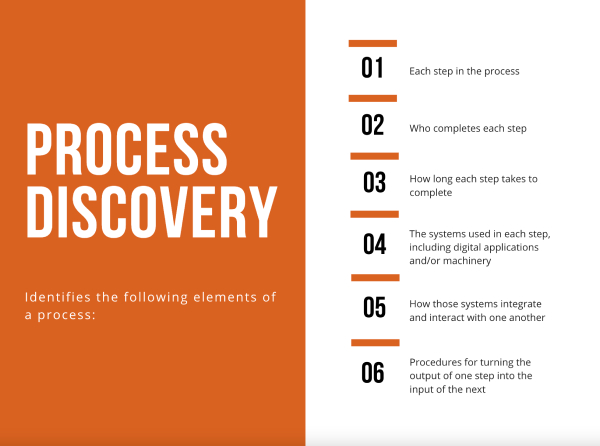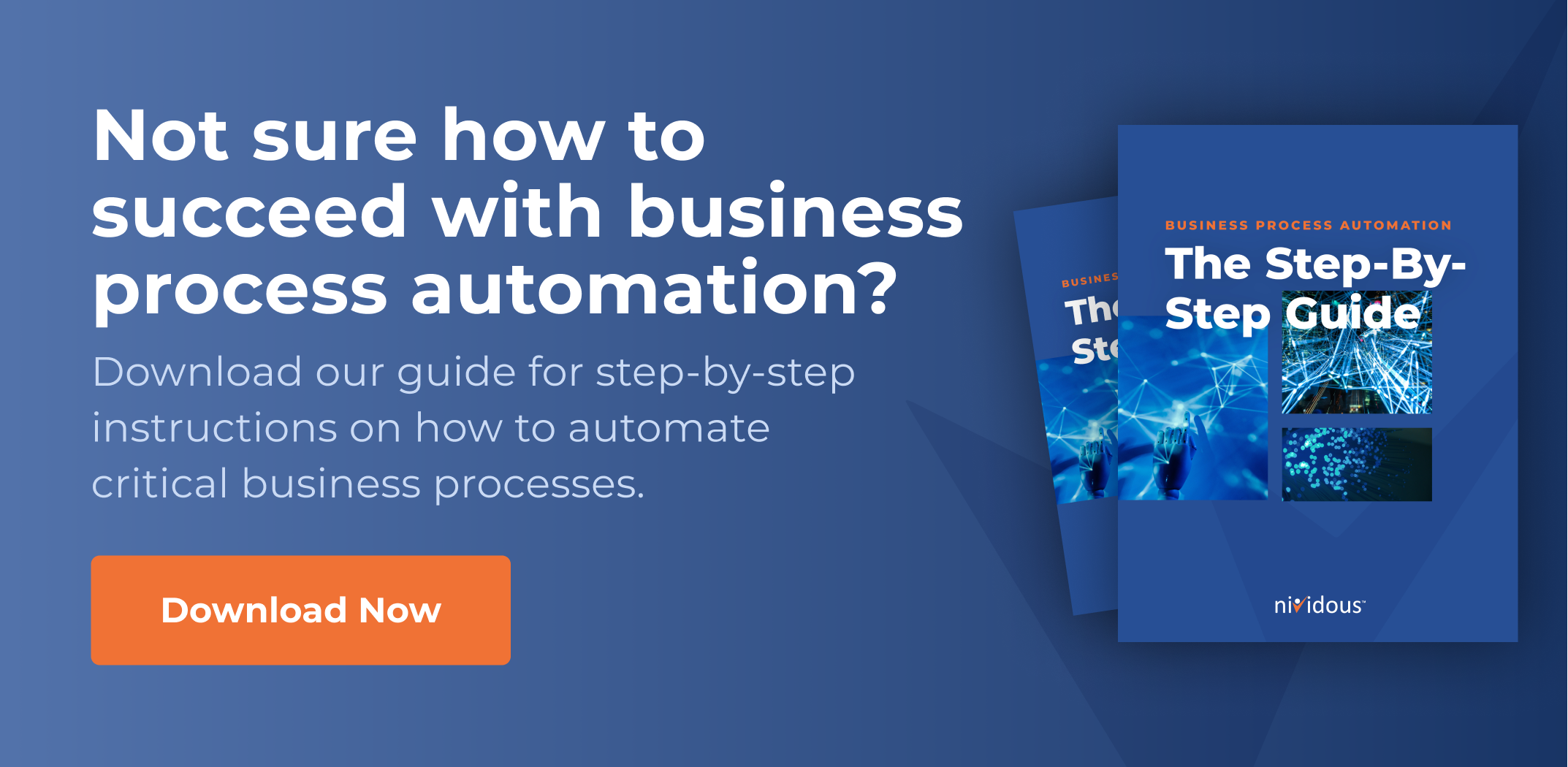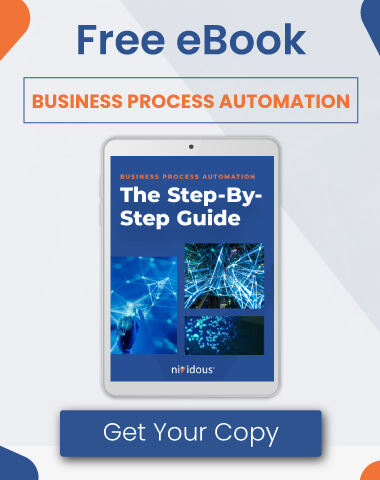A business process is a series of workplace tasks that accomplishes a goal. Companies have processes for onboarding customers, paying out invoices, receiving payments, and countless other core operations.
Odds are, those processes aren’t perfect (few things are). But to improve business processes, you have to understand them as they are, inside and out. You need to document the existing process before you can get to an optimal state that delivers lower costs, produces fewer errors, and provides a better experience for employees and the customers they serve.
The act of identifying and documenting a business process is called process discovery. A successful process discovery project typically identifies the following elements of any business process:
- Each step in the process
- Who completes each step
- How long each step takes to complete
- The systems used in each step, including digital applications and/or machinery
- How those systems integrate and interact with one another
- Procedures for turning the output of one step into the input of the next
With this information, a business process analyst can create a functional workflow map for the entire process, from start to finish. That map may become a framework for end-to-end intelligent automation, in which digital systems and human employees work hand-in-hand to complete entire processes—not just discrete tasks within those processes—more efficiently.
Struggling with an inefficient process?
Reach out to the automation experts at Nividous to get started with process discovery.
The Nividous platform enables this sort of hyperautomation—and when we implement the platform in a new environment, we always start with a process discovery phase. Without knowing how the work gets done, you can’t automate it. Process discovery is the foundation for all end-to-end process automation, and we have a lot of experience in the practice. If you’re new to the subject, here are a few things you should know.
Business Process Discovery: Key Challenges (And How To Overcome Them)
Whatever the process—payroll, shipping documentation, compliance—it’s getting done. So you’d think process discovery would be easy. All you have to do is ask the person who does the work, right?
Unfortunately, it’s not that simple. Here’s why process discovery is best pursued as a formal practice, a science of codifying exactly how work gets done—and why it’s wise to bring in an outside specialist rather than going it alone.
- No single manager has full visibility into the tasks that make up the process. If a process is a series of tasks, those tasks are usually divided between many employees—and even multiple departments. Managers see the big picture; they make sure the entire process is successful. But they can rarely get into the details of individual tasks within that process.
- No single employee has full visibility into the process beyond the tasks. An employee may engage in a handful of tasks at any given time, and each of those tasks may contribute to a different process. It’s tough to untangle each thread of work to see how it fits into the full process tapestry. Process discovery requires a comprehensive picture of the work, and most employees are too busy focusing on the task to get the broad view.
- No single task gets done the same way every time. In a department with 12 employees, you may find a dozen ways of doing the same thing. Process discovery can help streamline different techniques into a unified way of doing things. That requires a compilation of detail from multiple sources; no single interview is enough.
So how do you overcome these challenges? Bring in a specialist.
Process discovery weaves the narrow perspective into a broad view. It identifies the process at every level, from the individual tasks to work hand-offs to meeting the established goal. It documents the practice of goal-completion from beginning to end, and everything in between. It’s a specialized task, one best completed by a third-party expert with an objective viewpoint.
This argument still leaves a key question, though: What about automated process discovery tools?
Digital Process Discovery Tools Vs. Manual Process Discovery
With the rise of business Artificial Intelligence (AI) and the proliferation of process discovery tools it has empowered, business owners may be tempted to take a fully digital approach to process discovery.
You’ll get better results by starting with a human business analyst who knows how to observe work, talk to frontline employees, and create an accurate workflow map of an entire business process from scratch.
These tools can be extremely helpful, but we’d still recommend bringing in an experienced process analyst. Our recommendation may change as technology evolves, but as of now, human expertise still gets the best results in business process discovery. That said, digital tools can and often should work alongside human analysts. We even offer a process discovery tool within the Nividous platform (it’s in beta as we publish).
In fact, digital process discovery tools often require significant manual effort to reach production readiness. These tools draw data from computer usage: keystrokes, clicks, applications opened or closed. Then the tool tries to correlate those events into broader tasks and processes. The trouble is, there’s a lot of noise; humans don’t always work in a linear fashion. They may have 15 tasks running at once, and they may even use computers for non-work purposes. Today’s AI struggles to accurately compile all this disparate data into a clear picture of a business task, let alone process.
It usually takes human expertise to distill the tool’s findings into an actionable picture of the process. You’ll get better results by starting with a human business analyst who knows how to observe work, talk to frontline employees, and create an accurate workflow map of an entire business process from scratch. We know that’s true because we’ve seen it work again and again. Here’s an example of how automation improves business processes—in a case that began with process discovery conducted by an expert, not a software tool.
How Process Discovery Contributes To Automation: An Example
Not long ago, the leaders of a mineral-product manufacturing firm took a close look at their Accounts Payable (AP) procedures and realized they could be more efficient—significantly so.
Simply paying out invoices was a tremendous effort. The company received hundreds of invoices every month. It took four full-time employees, and sometimes more, just to transcribe invoice data from digital documents into the Enterprise Resource Planning (ERP) system (which was SAP, for the record). Approvals had to run up the chain of management and come back down. And in the frenzy of keeping up with the paperwork, errors were common enough to frustrate the vendors—eventually leading to a loss of business.
The manufacturer reached out to Nividous, who sent in a team to document every detail of the paying out invoices. These business analysts and system architects completed an in-depth process discovery phase, documenting steps, people, and systems that made up this process. That enabled them to create a workflow map in the Nividous platform’s Business Process Management (BPM) system—a BPM implementation that became a framework for deploying AI-enhanced Robotic Process Automation (RPA) bots.
| Smart RPA Bots From Nividous |
|---|
| An RPA bot is specialized software that automatically performs digital operations through application user interfaces—which means they can integrate any combination of systems, and operate them the same way humans do (only faster and with fewer errors). The Nividous Smart Bots in this story also incorporate machine learning and computer vision to get accurate data from a wide variety of digital invoices, regardless of the formatting. |
The Nividous platform deployed RPA bots to move invoice data from digital documents into SAP, ultimately delivering savings of more than 1,000 staff-hours per month, so the workforce could pivot to more valuable tasks. It also reduced the invoice processing turnaround time by 90%, and completely eliminated human error from the process.
But Nividous couldn’t have achieved these results without clear documentation of the existing process. For more examples of intelligent automation in action, browse our case studies. Every single one was made possible, in part, by business process discovery.







![Business Process Automation: Your Complete Guide [2023]](https://nividous.com/wp-content/uploads/2023/09/Business-Process-Automation-Your-Complete-Guide-2023-Blog-Feature.webp)